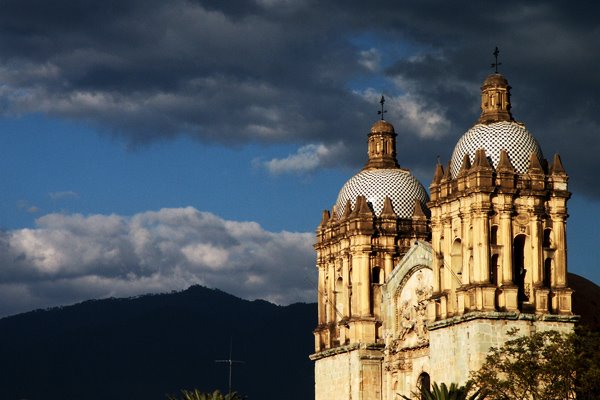
As a non drinker, I love mezcal. First, the plant from which it is made is close to magical. The agave provides not only mezcal, but also needle and thread, water and paper. How cool is that?

Second, drinking it is a part of the culture, a culture deep and ancient. As my main man the Dali Lama says, "It is their ritual, baby. You must roll wid it." or something like that.
So I have respectfully learned to observe the traditions, while struggling not to get too buzzed.

Mezcal is made all over the state and everyone has an opinion as to where the best is made. Santa Catarina de Minas? Chichicapam? Matatlan? Mitla? Villa Sola de Vega?

Well, this time it was off to San Juan del Rio, a village deep in the mountains past Mitla.

After driving an hour or so through dramatic country on decent roads, we arrived in San Lorenzo Albarradas, where we found several palenques right off the road.

The first was run by Santos Martinez Cruz.

It was a fastidiously clean place. While we were there, a couple of folks stopped by to get mezcal. Santos said lots of taxi drivers stopped there. We wondered if it was the riders or the drivers buying.
This horse is indicative as to how healthy the animals we saw were. There were no underfed or skinny burros, horses, sheep, oxen, or goats. All of them looked great and that tells one quite about about the area and its inhabitants.

We turned off the paved road and drove 20 or 30 kms across the ridges atop the mountains. We could see a river, but it was way down and we marveled as to how the road snaked its way there with lots of cutbacks and dust.
Eventually, we arrived in San Juan to discover that the recent rains had completely washed away the road and there was no way through. Actually, there was, but it meant turning around or backing out a narrow road with steep cliffs off to one side. We got out and walked.
Because the village was at the base of a deep gorge, there was not much land on either side. Basically it was a house on one side of the road, one on the other side and then the river, so it was long and narrow village. Even with the road washed out, one could tell that it was a prosperous town. Houses were large and well kept. Late in the day, the church was quiet, but 30 minutes later the patio was filled with kids playing football.

Dora the Explorer is everywhere.

Of the nine palenques in San Juan, all had been destroyed by the rains, except one, which was up and running. We got the tour. Adolfo Hernandez Juan minding the fire.

Of course, people had mezcal to sell from stored stock. We helped support the local economy.
A mound of dirt? No, roasting piñas.

Uncovered after a few days, they look like this.

Just to show the scale and size of the piñas.

They were working very hard to get things going again although it would still take a few weeks or months.

We had driven across the mountains and through several micro climates in which the plant life varies and changes greatly. Deep in San Juan we found bananas and mangos. It was a touch of the tropics.

There seemed to be a lot of community work going on to rebuild not only the palenques, but the central road. The village had a very nice vibe, simple as that.
After a couple of hours, it was time to head back to San Agustin Etla, a pretty good drive. So I backed the car up and managed not to fall off the cliff or hit the parked bus blocking the road. A quick stop in Mitla to eat at a place run by some very happy women who had just set their comal up by the side of the road.
¡Viva San Juan del Rio! We will be back. And thanks for the 25 liters. Incidentally, the prices were quite low ranging from $30 MP to $80 ($2.50 - 6.50 US) We did buy some tobala ( a type of agave) for $120 MP, but it was exceptional. A bottle of it could go for hundreds of dollars in the States. Nothing like getting it from the source, eh?
So, as a non-drinker, what do I do with all this mezcal? Keep the tradition going, baby. Every visitor or worker is offered a taste and they all begin to talk about where they think the best is from. I'm keeping a list. Lots of good places to visit. The trip continues.....



3 comments:
I am shocked by the size of the pinas. I got a sense of their size in the photo of the horse, the horse giving perspective.
what a delightful trip! As a mezcal imbiber myself, I am pleased to know of yet another village to visit and taste!
wow you posting this was great, its my hometown glad to know things are going well :)
Post a Comment